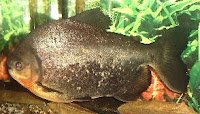Hi all. On today’s chapter, I will going to share with you some info on Labyrinth Fish. Ummm…How do I start…Well, did you guys out there know the definition of Labyrinth Fish?? I bet you guys already know, but since I’m already asking, I’m going to tell it though…Hehe. Labyrinth Fish is a fish that have an organ called…Labyrinth that give them the ability to breathe air through their skin. Their name is actually comes from the thing that they have. The labyrinth organ is used when the water have low oxygen level. It consists of skin folds which filled with blood vessels that allows the oxygen to be absorbed from the air.
Inside my tank, I have 2 Giant Gourami, 3 Pearl Gourami, 3 Dwarf Gourami (1 of them died today), 1 Blue (2 Spot) Gourami, 2 Yellow (2 Spot) Gourami, 2 Climbing Perch…and the my late Siamese Fighting Fish.

Photo 7.1 : My Yellow Gourami

Photo 7.2 : Under the tail of the Black Koi is my Giant Gourami and on the left is my Pearl Gourami and Yellow Gourami

Photo 7.3 : There...its my Dwarf Gourami and my Pearl Gouramis
Taking care all of them is not an uneasy task. Even a 10 year old kid can take the responsibility for keeping that kind of fish. They only need basic maintenance and they are also hard to be infected by common disease. Maybe due to their natural environment in the wild makes the fish is so hardy. In Malaysia, we can easily caught the 2 Spot Gourami in paddy field and crops irrigation. In their natural habitat, they can easily be found hiding under floating vegetation since they usually suck or breathe on the surface, hiding under the floating vegetation is a great way to avoid being strike by predators like Kingfisher Bird or small snakes.
So…generally the Labyrinth Fish such as Gourami and Climbing Perch are not difficult to handle. They prefer dark and calm area. So make sure your tank is not too bright. If you have to do so, make sure you put some real or fake floating plants as a hiding place for the fish, and the water current must not be too strong. The fish is also a great community fish, they do well in schools and always swims with their type. They usually not bothering other species but they must never be mix with fin nippers. In natural, the Gourami is actually the weakest link of all the Labyrinth Fish while the Climbing Perch is the hardiest of them all. The Gourami easily get ‘high’ or ‘dizzy’ when they are exposed for to long out of the water. Unlike the Climbing Perch which some also called Tarzan Fish, it can climb trees (“I’m not so sure about it”- Elham) and can also walk on land (“This one is true”- Elham). At my hometown people will gather around a pond which used to be paddy field long time ago to scoop for fish after the raining season. The water from the pond is drawn out using of course…the water pump. When the pond is dried, the fish is collected and normally we have Catfish, Gourami, Climbing Perch and maybe some small snakes. We are not eating the snake of course. At that time, we can see as other fish is dying the Climbing Perch calmly ‘walks’ to find other source of water. Yes, the Climbing Perch can walk by using their special equipment located under their gill covers. There are thorny edges that will be use as foot for walking and the direction is propelled using their fins and tail. Some even says that the fish can survive outside the water for several days!!!

Photo 7.4 : Climbing Perch natural habitat...Paddy field ditches

Photo 7.5 : The male(top) is more slender than the female(bottom)

Photo 7.6 : My Climbing Perch. He didn't obey my orders to SMILE!!!
Some also claim, the Labyrinth Fish must breathe together underwater and on the surface as well. If the fish is kept underwater for too long, the fish will eventually drown!!! Just like the whale and dolphins.
Almost all species of the Labyrinth Fish didn’t care much about the water quality. They can live is almost every water condition but not is the sea. In their natural habitat, the water condition is ranging from slightly acidic and medium hard to soft water and the temperature from 20°C to 27°C. You can feed them with fish pallets or flakes and enjoys so much on bloodworms and tubifex worms.
For me, this Labyrinth Fish especially my Gourami and Climbing Perch didn’t gave me much problem from the day I bought them until today. They come with different type of variation, some of them is so beautiful yet is so easy to taken care of. I am recommending this fish for all beginners out there. Go find them!!! Wait, did you also know that there is a mystical beliefs about the Climbing Perch?? Maybe you have never experience it before but in Malaysia they are so popular about this kind of mystical thing. All the 3 biggest races in Malaysia which is Malays, Chinese and Indians have their own story on this kind of fish. But this beliefs is not so strong today compares to long time ago. Wanna know more?? Meet me in the next chapter. Until then, Please take a good care of your fish.
















.jpg)
.jpg)
.jpg)

































